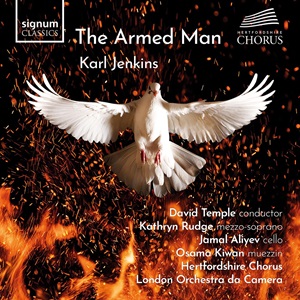
Sir Karl Jenkins (b. 1944)
The Armed Man (A Mass for Peace) (2000, arr. composer for mezzo-soprano, chamber orchestra and choir)
Osama Kiwan (muezzin), Kathryn Rudge (mezzo-soprano), Jamal Aliyev (cello)
Hertfordshire Chorus
London Orchestra da Camera/David Temple
rec. 2022, St Augustine’s Church, Kilburn Park Road, London
Signum Classics SIGCD779 [67]
I don’t have the actual data at hand, but I would expect that The Armed Man is among the most performed classical works written this century. So it was to my great surprise that I found that this is the first recording of the full work under the direction of someone other than the composer, and only the second released since the original back in 2001 with the London Philharmonic and the National Youth Choir. Given the circumstances the world finds itself in, it seems a very appropriate time to release this mass for peace.
This arrangement, made by the composer, is intended for smaller ensembles than a full symphony orchestra and choir, without losing the overall impact of the piece. This recording has an orchestra (including organ) of 30, and a choir numbering 88. So it is not quite the same reduction in scale that is, for example, the chamber version of Carmina Burana.
I suspect that the great majority of those who have opted to read this review will be very familiar with this work. For those of you that aren’t, let me provide a brief précis. It was commissioned in 2000 by the Royal Armouries Museum to commemorate the new millennium. Jenkins assembled texts from various sources, including the Requiem Mass, the Islamic call to prayer, the Sanskrit epic Mahabharata, Alfred Lord Tennyson, Rudyard Kipling and Sankichi Toge, a survivor of Hiroshima. In that regard and also its anti-war sentiment, it follows the tradition of Britten’s War Requiem and Vaughan Williams’s Dona nobis pacem. Musically, the latter is a good guide to the style, along with Carmina Burana and Fauré’s Requiem. Jenkins also employed the early French song from which the title of the work comes. I recognise that his music divides opinions, but for me, this work has exceptional beauty and great drama.
The main feature of this recording is the new arrangement, and how it works in preserving the emotion and drama of the full symphonic version. Simply stated, it does so very well. In some places, the lighter orchestral textures help illuminate certain details. When required, the performers can make plenty of noise, such as the opening of the Torches movement, and the climax towards the end of the famous Benedictus.
Jenkins has cut back his requirement for solo singers to a single mezzo role, and this is perhaps the least successful part of the arrangement. One might have thought that the original scoring could have been retained, with members of the choir asked to fill the roles. I was surprised by the degree of vibrato employed by soloist Kathryn Rudge, particularly in the Kyrie. For me, it seemed more in keeping with Verdi’s Requiem than this work. The clear, vibrato-less solos in the original recording are far more effective.
The choir and orchestra play their parts very well indeed, and the cello solo in the Benedictus is beautifully performed. The tempos adopted by David Temple are very similar to those in the original composer-led recording. The sound quality is very good, and the notes are a definite improvement on the original.
For lovers of this work and composer, this should be on your wish list. For those new to the work, I would suggest that the original is the place to start, but there are lots of really good things about this new arrangement and recording.
David Barker
Help us financially by purchasing from




















